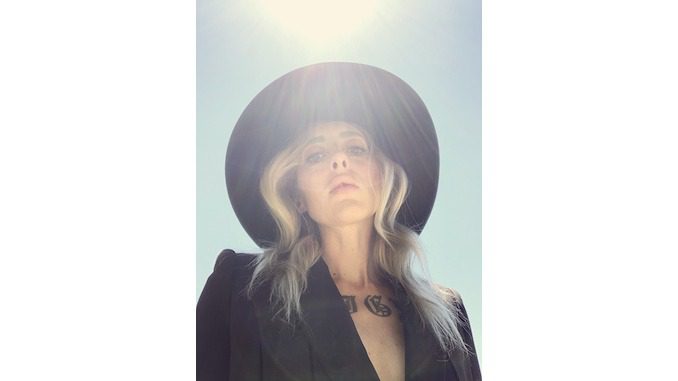Who was this woman named Layla? How did she come to be the title of Eric Clapton’s best-known song and best-known album? And how did she come to be the inspiration for the Tedeschi-Trucks Band’s new, four-LP collection, I Am the Moon?
As any consumer of rock-star gossip knows, Clapton wrote the songs for the Layla album out of his love for Patti Boyd, the wife of his best friend George Harrison. The love was as intense as it was seemingly impossible, and out of that tortured impasse came Clapton’s songs of thwarted passion. To protect the identities of those involved, he used the name of Layla, the heroine of the 1188 Persian poem Layla and Majnun.
Why did he choose that name? Because Nizami Ganjavi’s epic, narrative poem also dealt with unconsummated desire. In the Arabian desert, two young cousins, Qays and Layla, fall desperately in love, but her father vetoes the partnership and forces his daughter to marry a rich merchant. Qays flees his tribe and wanders in the desert, making up poems about his unattainable dream. The locals soon nickname him Majnun, or “Crazyman.” Layla still longs for him, but when they finally meet again years later, they are too overcome to say anything. Eventually, like Romeo expiring on Juliet’s tomb, Majnun dies near his beloved’s grave.
“There are poems and songs in every culture about love for the one you can’t have,” says Derek Trucks. “It’s a theme that’s not going away anytime soon. You can see how Eric drew from that poem. We ended up doing something similar, drawing from the poem rather than retelling it.”
Like the Clapton album, the Tedeschi-Trucks Band’s I Am the Moon is inspired by Ganjavi’s poem without recycling its characters, setting or plot points. If you listen to the four LPs without knowing the backstory, you’d be more likely to think these funky songs were set in 1970s New Orleans than in 12th-century Persia. And yet the 24 songs all explore the double-edged nature of love, just as Ganjavi and Clapton had, acknowledging that it can spark the highest thrills and deepest pains, that its obsessions can create galvanizing motivation or crippling paralysis.
“Even in the beauty of love,” Susan Tedeschi says, “there can be jealousy, power trips and distance; not everything is bubblegum and champagne. There’s always some kind of conflict, some kind of suffering. At the same time there’s beauty in learning these lessons. Sometimes when you have to work for something, it means more than if it comes really easily. On the other hand, you can’t just think of yourself; there are other people involved. What do they think? What does Layla think?”
Both Tedeschi and her husband/bandmate Trucks have personal connections to the Layla album, which was credited to Derek and The Dominos. Trucks was named after that group’s fictional bandleader, and his uncle Butch Trucks had been a founding member of the Allman Brothers Band, whose namesake Duane Allman had served as the guitar foil to Clapton on the Layla project. Tedeschi was born on the day that album was released.
Because of those links, the Tedeschi-Trucks Band learned and performed the entire Layla album for the 2019 Lockn’ Festival in Arrington, Virginia, with Phish’s Trey Anastasio providing the second lead-guitar parts.
“The plan wasn’t to make an album,” Trucks says, “but we tape everything we do, and it turned out so well that we released it as Layla: Revisited. When you’re learning a whole album rather than just a song or two from it, you have to dig into the lyrics, what holds the thing together and where the musicians were coming from at that time and place.”
In their research, Tedeschi and Trucks saw how the ambiguities of love can inspire great songs, which in turn can inspire great playing. This fed the dynamic that has made the Tedeschi-Trucks Band a rarity on the jam-band scene: an act that excels at singing and songwriting as much as at soloing.
As 2019 drew to a close, the band was at a pivot point. Bassist Tim Lefebvre had left the year before; the band’s longtime keyboardist Kofi Burbridge had died from lingering heart problems in early 2019, and drummer J.J. Johnson was on his way out the door. Between their solo bands and their joint project, Tedeschi and Trucks had been touring almost nonstop for more than 20 years.
“We had planned on taking a break in March and April of 2020,” Trucks explains, “because we needed a chance to reset after we’d been going full-blast for so long. Kofi had passed; Gabe [Dixon] had come in on keys, and we had a whole new rhythm section. You can’t change that many musicians and not change the band. I didn’t want to just keep banging down the road as if nothing had happened. We needed to process it. Then, a few weeks into that time off, the bottom of the world fell out.”
That was the pandemic, and suddenly a voluntary short hiatus had become an involuntary, long-term lockdown. Early on during that enforced isolation, the group’s male singer Mike Mattison sent his bandmates an email suggesting that they all read Ganjavi’s original poem.
“Mike, our resident historian, threw out the idea that the writing core of the band should read the poem and see what happens,” Trucks recalls. “It was like a band book club. We all accepted, because we had to do something to stop us from going out of our minds. It helped that Mike had sent his own synopsis with his dark, comic comments. As I read the poem, a lot of it seemed very similar to the lockdown. We were as isolated as Layla locked away in the tower. In both cases, there was a lot of wine drinking to cope with the separation.”
“It became a mental health thing,” agrees Tedeschi, “being away from our friends. When Mike wrote ‘Where Are My Friends?’ that really struck home. Some people used the time in a beautiful way; others just sat around and watched Netflix. People were getting depressed; I noticed my friends were drinking more.”
The band kept themselves busy to avoid that trap. Once everyone got tested and agreed to stay inside a circumscribed bubble, they were able to work on song ideas together. That’s why 20 of the 24 songs are co-writes by different band members (and such outsiders as Oliver Wood and Tia Sellers). For the first time in the band’s history, they had the luxury of more than a week and a half between tour commitments to work on an album.
“We had nothing on the horizon,” Trucks says, “so we just kept writing. You wake up in the morning and someone has an idea, and we get together and work it up, and that inspires someone else to come up with another idea the next day. One of the points Mike hammered into us early on was that in no way were we making a rock opera; we weren’t going to be storyboarding anything.”
Freed from their usual touring schedule, freed from the expectation to turn Ganjavi’s poem into the rock equivalent of Les Miz, the band’s main songwriters—Tedeschi, Trucks, Dixon, Mattison and drummer Tyler Greenwell—were unleashed to turn out one keeper song after another.
“Once we got past the 20-song mark, we realized we had tons of material,” Trucks remembers. “A lot of records get made where you write a lot of songs and then you start trimming till you get down to the best 10 or 12. But this didn’t feel like that; we didn’t have songs we could let go. At the same time, it was too much to listen to all at once. No one has the attention span to listen to two hours at one sitting—especially now. Even when I was listening to Songs in the Key of Life as a kid, it was months before I listened to the second LP, but I wore that first disc out.”
The solution, the band decided, was to divide the songs into digestible chunks: four separate albums, each given a different subtitle (Crescent, Ascension, The Fall and Farewell), and released one at a time, in May, June, July and August of this year. It is no coincidence, Trucks confirms, that the first two subtitles are the titles of John Coltrane albums. He could have called the third and fourth LPs Expression and Giant Steps.
“I could have,” Trucks laughs, “but everyone already knows Giant Steps. Not a lot of people are listening to Crescent and Ascension. Coltrane was on my mind. I’d been listening to A Love Supreme a lot, and when you look at that album’s back cover and see that the music is broken up into four parts, you know he means business. That gave me the idea.
“When I listen to music at home, I still like to listen on vinyl, and over the last four or five years, we’ve really drilled down on how to make a vinyl album sound good. We learned that once you get past 20 minutes, you start squeezing the signal and losing some low end. The sweet spot is 16-18 minutes per side. Once we came up with a sequencing that hit that sweet spot and also followed the story arc of exposition, development, conflict and conclusion, we knew we had it.”
One of the first songs to come out of the “book club” was Dixon’s “I Am the Moon,” a ballad of lonely anguish that has Layla addressing Majnun: “They tell me stories you’ve gone crazier / I could use a little help myself / I am the moon; you are the sun / Look at you flaming out in front of everyone.” It begins a bit dreamily, but as the song gradually builds, it becomes obvious that Layla is dissatisfied with being treated like an orbiting stone with no light of her own.
“The poem is all about his suffering, but what about her?” Tedeschi asks. “She’s saying, ‘I’m over here, I’m suffering too. You’re the sun, the big entertainer, it’s all about you. What about me, the moon?’ For Gabe to write that from a woman’s perspective was really badass. It reminded me of when I started writing songs as a teenager, because it’s such a healing way to work through your feelings, especially when you’re so infatuated by someone that you drive by their house every night just to see it. If Majnun had had a car, he’d have driven by Layla’s house all the time.”
That song prompted Tedeschi to write “Take Me as I Am,” an R&B demand for respect in the mode of Etta James or Bonnie Raitt. “Take me as I am,” Tedeschi declares over Dixon’s B-3 organ, “for I am just like you / We’re made from the same hand / Born of the same land.” Once again, the song builds—this time from patient persuasion to an impatient ultimatum.
“That song is saying, ‘Don’t judge me on how I look, whether I’m a woman or a Black man or an Asian [person]; we’ve dehumanized each other for far too long,’” Tedeschi explains. “There’s an arc in the song; at the start, I’m trying to be calm, calm, calm. But finally I get frustrated and say, ‘Come on, I’m the same as you. Why can’t you accept me as I am? Haven’t we suffered enough?’”
When they began tracking the songs, the band decided early on that they wouldn’t do anything as obvious as having Tedeschi sing all the songs from Layla’s perspective and Mattison sing all the numbers from Majnun’s point of view. “I Am the Moon,” for example, finds Dixon singing the first verse and Tedeschi the second, even though Layla is speaking in both. By contrast, Tedeschi sings all the vocals on “Playing with My Emotions,” though Majnun is speaking in the first verse and Layla in the second.
“Just like in a musical or a play, a character doesn’t have to be the same gender or age as the person who’s singing,” Tedeschi argues. “In the past few years, I’ve given into that idea that I can sing as anyone. That’s why I could sing Eric’s songs about loving a woman on Layla. I can understand different perspectives I didn’t have before. I can relate to people better. I don’t have to be just Susan when I go out there; I can be any character. I grew up acting, and I even played men. The one time I won an acting award was for playing a boy.”
Despite the origins and setting of Layla and Majnun, there are no explicit references to the Middle East, neither in the lyrics, nor in the music. The band could have incorporated tablas, ouds and sarods, says Trucks, who loves those instruments, but that’s not the kind of band he’s in. What’s important, he decided, was the theme of the poem, not its time and place. “You make the music you make,” he says, “and I’ve learned not to run from that.”
If the music reflects a place, it’s the Florida of the Allman Brothers and the Louisiana of the Neville Brothers. The jazzy blues of Duane and Gregg Allman’s band is prominent on tracks such as the Burbridge elegy “Soul Sweet Song” and the project’s only instrumental, the 12-minute “Pasaquan.” The second-line funk of Art and Aaron Neville’s band is heard on tracks such as “Fall In,” “Gravity” and “Ain’t That Something.”
“Isaac Eady, our new drummer, lived in New Orleans forever,” Trucks points out, “so his natural thing is to send it there. Most of the band is from the deep South, so New Orleans is always in the mix. There’s a looseness in the way our horn section plays that feels like that.”
The large ambitions of I Am the Moon make evident the special nature of the Tedeschi-Trucks Band. The group has always maintained an unusual balance between singing, songwriting and playing. The vocals are never merely just an excuse to get to the solo, and the solos are never a digression from the lyrics. The ensemble had always made sure that each aspect reinforces the others. The new project’s grand scale merely makes that more obvious than ever. This may seem unusual in today’s jam-band scene, but it wasn’t always so.
“I think back to the Allman Brothers,” Trucks says. “They had the musicianship in a headlock, but they also had Gregg Allman who could sing with anybody in the world and could write some amazing songs, especially in the early years, I feel we have the same thing. Susan can sing with anyone in the planet and can write some great songs. We can tap into that world. There’s a reason people are still playing those Grateful Dead songs.”
I Am the Moon
is out now on Fantasy Records.




